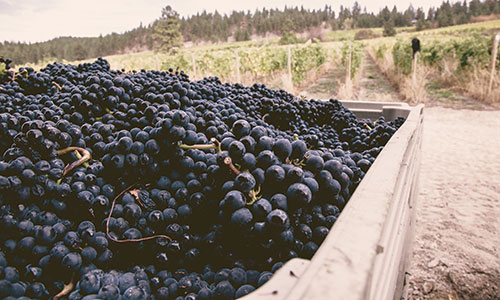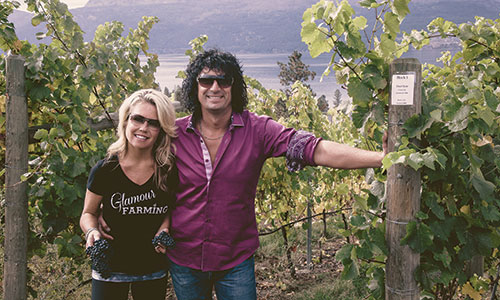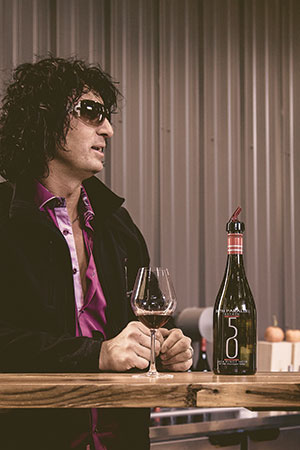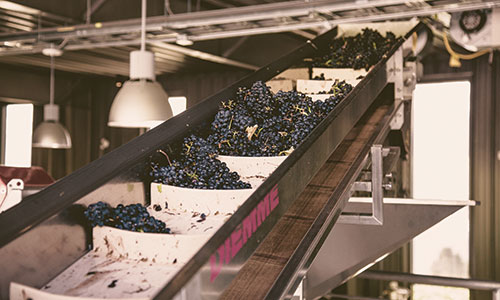Curtis Krouzel takes a new path to perfecting pinot noir
On a brisk october day, Curtis Krouzel stands tall – six-foot-four-and-a-half, to be exact – in his vineyard about 30 minutes north of Kelowna, British Columbia. He and the virtuoso winemaking team of Grant Stanley and Matthew Fortuna have been obsessively watching the grapes here at 50th Parallel Estate winery for weeks. Krouzel (Engineering Design and Drafting Technology ’95) crouches, selects a cluster of grapes, and takes an enthusiastic bite.
“Perfect,” he declares.
Today, a marathon of physical labour begins: picking, crushing and moving juicy mashes into fermentation tanks. Krouzel, Stanley and Fortuna have decided to start picking the pinot noir grapes. Days will be long and detailed plans will be put to the test. This grape accounts for roughly 40 per cent of the winery’s bottles, by far the majority share of the roughly 13,000 cases it produces each year.
“Everything is about pinot noir here,” says Krouzel. “It’s the hardest grape to grow and the hardest wine to make, so if you don’t focus on it…”
If anyone is focused on the business of winemaking, it’s Krouzel.
In the midst of this year’s harvest, he’s executing a multimillion-dollar expansion that will not just boost production but redefine the Canadian winery experience – and, hopefully, increase 50th Parallel’s share of B.C.’s wine industry, which has an annual economic impact of $2.8 billion.
To help make it happen, Krouzel has put his engineering background to work on nearly every aspect of production, and made technology and innovation a key part of his success with the notorious “heartbreak” grape.
Despite the demands of the day ahead of him, Krouzel is dressed with style. He’s wearing a raspberry-hued, tailored dress shirt, black slim jeans and baby blue Versace ankle-height cowboy boots. The look is topped by his signature mane of tousled black hair. He’s clearly not into half-measures with his wardrobe, nor with his ambition for his winery.
 Staking a claim in wine country
Staking a claim in wine country
Krouzel’s appreciation for wine and winemaking came early in life, while growing up in Edmonton as the son of European immigrants.
“My mom is Slovak and my dad is Czech. Mom always made wine at home.”
But his eye for design and aptitude for technology led him to NAIT.
There, he learned fundamental engineering design processes and drafting by hand. As it was the early 1990s, there was a module on Computer-aided Design (CAD), the “new” technology that used computersto create 3D drawings.
After graduating, Krouzel started a drafting and design company called Alberta Technical Design. In 2004, he started another: Plant Solutions, which offered construction planning, and simulation and safety training scenarios.
Along the way, Krouzel had developed a passion for the temperamental pinot noir grape and its demanding-yet-seductive wines. For years, he’d dreamt of owning his own destination winery. In 2000, he met someone who shared that dream – Sheri-Lee Turner (below, with Curtis) – a petite blonde with a commerce degree and an entrepreneurial energy that matched his own.
As they pursued their own independent business ventures (she owned some Curves fitness centres and a marketing agency in Calgary) they began to think seriously about life in Okanagan wine country.
They had their eyes on an old 61-acre cherry orchard. Located in Lake Country between Kelowna to the south and Vernon to the north, it had jaw-dropping views and a grape-friendly, southwest-facing slope.

Krouzel and Turner gathered a few investors and put a deal together the same week as their 2008 wedding. They spent their first year as husband and wife clearing land and planting grapes, initially by hand, in the pink feldspar granite soil.
“This was the hardest block to plant,” recalls Turner-Krouzel, as she joins her husband high up the slope among the vines being picked.
Like Krouzel, she doesn’t look the part of a typical grape farmer.
Turner-Krouzel tromps through the vines in high heels and designer sunglasses. The words Glamour Farming are written in rhinestone studs on her shirt, a phrase she’s trademarked in association with 50th Parallel. She pauses to reply to a text on her phone, her manicured fingers flying as she multitasks.
“I love hard work and I love the beauty of this land. Wear your sparkly shades, have your pretty nails. But at the end of the day, you’re farmers.”
And, in Krouzel’s case, an engineering technologist. To help with that hard planting, he turned to his design skills to build a tractor-drawn plough that would work on the sloped, rocky site, complete with seats for two planters who could drop vines into the trench it would dig and then fill. It would even pick up a vertical surveying laser as a guide for straight, perfectly spaced rows.
“We could do 1,300 plants a day. Everything after the planting machine is perfectly aligned and perfectly straight,” he says with a grin.
They made their first wines – about 700 cases – in 2011. It was a makeshift operation, run out of a 1980s red Quonset hut that came with the land. Nevertheless, the wines won national and international awards and accolades. By 2013, they were up to 5,000 cases. The winery continued amassing national and international awards for its rosé with its delicate palate of strawberries and guava, its red with its spicy cherry notes, and its pinot gris white, featuring a lively peach and citrus profile.
With just three vintages and 44 acres on the property under vine, it was time to make another major capital investment. Krouzel worked with architects to plan, design and build the next stage. Their concepts flowed from Krouzel’s direction that pinot noir grapes need to be handled gently yet quickly.
“Of all the wine grapes, pinot noir wants to be vinegar the fastest,” Krouzel explains. “The skins are very thin and can be broken easily. It wants to oxidize” – or basically spoil like an apple goes brown. “Pinot needs to get from vine to tank to barrel as quickly as possible.”
 As with his planting machine, Krouzel made CAD drawings to improve the process and meet his vision for future production capacity.
As with his planting machine, Krouzel made CAD drawings to improve the process and meet his vision for future production capacity.
The architects ran with his specs, creating a streamlined winery that is positioned at the bottom of the hillside vineyard, allowing the winermakers to quickly transfer the harvest from the vines to the adjacent crushpad and then into the waiting hatches of six 7,100-litre stainless steel fermenters.
The process simply uses gravity, proceeding as gently as possible with minimal mechanical intervention and risk of damaged grapes.
The 930-square-metre (10,000-square-foot) winery opened in spring 2015, the same year 50th Parallel won a prestigious Lieutenant Governor’s Award for Excellence in British Columbia Wines.
“You can’t be a pretender,” says Dave MacIntosh, Vancouver-based regional director for PMA Canada, one of the country’s largest independent beverage alcohol agencies. He admits that he dismissed Krouzel’s winery concept on their first meeting years ago, when he was skeptical of the overly ambitious plans.
But a year after that meeting, he saw the property and how it was being transformed by the Krouzels’ tireless work ethic and dedication to their vision. “Most people would never have gotten that far,” says MacIntosh.
“They’ve kept this thing alive by their fingernails at times. But there’s a lot of intellectual horsepower out there.” Unlike many winery owners who are more comfortable among the equipment and oak barrels, “They’re out there every single day, brand-building and promoting.” That is, when they’re not farming.
“I’m in awe of their big-picture thinking.”
Unparalleled vision
A winery expansion – including a brand new lake-view tasting room, restaurant and banquet space– has always been part of the Krouzels’ big picture. There’s $250,000 worth of excavation already done, but a construction boom in the Okanagan has made coordinating development permits and tradespeople a challenge.
Cost estimates for the 4,570-square-metre (15,000-square-foot) expansion have gone from $3 million to almost $5 million during a delay of several months. Krouzel, however, has calculated that the restaurant space alone will infuse $2 million into sales revenue on site.
 50th Parallel hosted 20 bookings in 2016, many of them on a 280-square-metre (3,000-square-foot) event pad high up in the vineyard with a sweeping, bird’s-eye view of the vines, the winery and the lake below.
50th Parallel hosted 20 bookings in 2016, many of them on a 280-square-metre (3,000-square-foot) event pad high up in the vineyard with a sweeping, bird’s-eye view of the vines, the winery and the lake below.
In the meantime, they’ve already been testing the waters for wedding and event spaces, which are in very high demand in the Okanagan, generally booking a year or two in advance.
“It’s very private and very quiet,” says Turner-Krouzel, who handles bookings.
“We’ve done 60-person private dinners up there, to 220-person weddings.” Clients can even shuttle to the winery via its private helipad.
Even though construction on the new facilities is only getting underway, Turner-Krouzel is able to meet with prospective wedding and other clients and “show” them the interiors and the view from the restaurant and event space thanks to 3D renderings of the plans and virtual reality goggles.
“It’s a sales tool for Sheri-Lee,” says Krouzel. “As soon as a client sees the spaces– even though the buildings aren’t complete – they sign on the dotted line.
“All of it is visualizable,” he adds.
Even the construction contractors have been equipped with virtual reality goggles. It makes for surreal progress meetings, but Krouzel says that “being able to see this whole project in 3D” is critical. He estimates that it will smooth out the construction process, saving about 10 to 20 per cent on time, and therefore costs.
For all this, Krouzel hasn’t lost sight of the wine. He knows it’s the economic engine that will keep this enterprise afloat. That’s why the expansion also includes increasing production to 25,000 to 30,000 cases. This will allow, in a few years’ time, the final phase of the dream to be built: on-site guest accommodations and a unique wine-oriented spa. It will be a $30-million investment in total, he says.
“This has been the vision from the beginning.” And Krouzel has the CAD drawings to prove it.
Peculiar pinot noir
Called the “heartbreak grape,” pinot noir has notoriously thin skin, making it susceptible to damage and spoilage before it’s fermented. Leaving the juice in contact with those skins for a short time, however, gives the final product – from silky reds to beautiful sparkling wines and rosés – a light raspberry to garnet colour.
The final product is also affected by the environment. Pinot noir’s complex genetics allow it to develop different compounds based on its location and growing conditions. It loves light but not too much heat, so the reflection of sunlight off Okanagan Lake and the cooler nights make the central and north Okanagan fertile ground for pinot noir. In fact, it’s the region’s second most planted red grape.